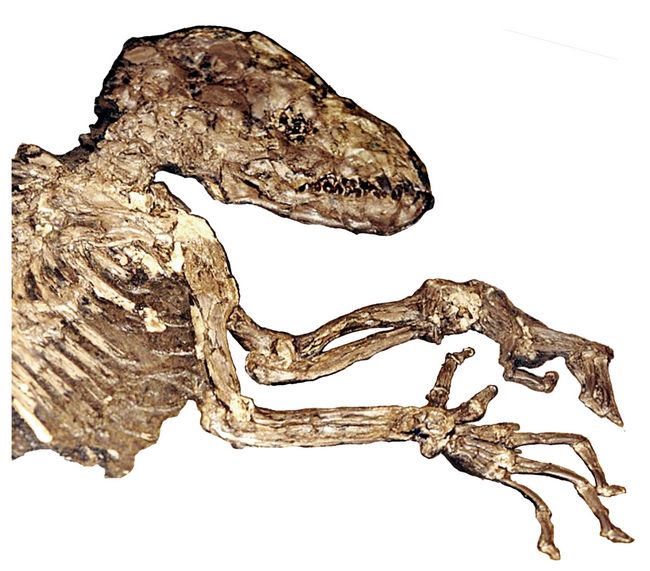Athena Review Image Archive ™
Darwinius masillae skeleton

Detail of fossil skeleton of Darwinius masillae ( cast;)
Darwinius masillae is an Eocene adapiform primate represented by the fossil skeleton of a juvenile, who died at the margin of an ancent volcanic lake in a rain forest some 47 mya, and was preserved in Middle Eocene sediments at Messel, Germany. In the fine shale layer which yielded the fossil, identified as that of a young female about 10-12 months old, traces of soft tissue were also preserved. The fossil was found in 1983 by private collectors who split the fossil into two parts. The fossil is now reunited, and has been analyzed in detail by Franzen et al. (2009).
Morphological characteristics preserved in Darwinius masillae (including various aspects of skull, teeth, and limbs) enabled a lengthy comparison with the two principal subdivisions of living primates, Strepsirrhini and Haplorhini. Strepsirrhini ("bent noses", as defined by Saint-Hilaire in 1812) have a moist nose and median cleft in the upper lip, and include Indri, Lemur, Loris, Nycticebus, Galago, and Tarsius. Haplorhini ("simple noses", as defined by Pocock) have a dry nose and continuous upper lip, and include Tarsioidea and Anthropoidea as suborders.
Defining characters of Darwinius ally it with early haplorhines rather than strepsirrhines. This is somewhat surprising, since fossil adapiform taxa have heretofore been identified with lemur-like or strepsirrhine characteristics.
Darwinius masillae is considered important in being exceptionally well preserved, and providing a comparatively complete understanding of the paleobiology of an Eocene primate. Darwinius is not interpreted as an anthropoid, but the adapoid primates it represents, including Notharctus and Adapis, are seen to deserve more careful comparison with higher primates than they have received in the past. According to Franzen et al. (2009), Darwinius masillae, and adapoids contemporary with early tarsioids, could represent a stem group from which later anthropoid primates evolved.
References:
Jens L. Franzen. J.L. P.D.. Gingerich , J. Habersetzer, J. Hurum, W. von Koenigswald, B.H. Smith 2009. Complete Primate Skeleton from the Middle Eocene of Messel in Germany: Morphology and Paleobiology. PLoS One, Vol.4, issue 5.
.Copyright © 1996-2020 Rust Family Foundation (All Rights Reserved).